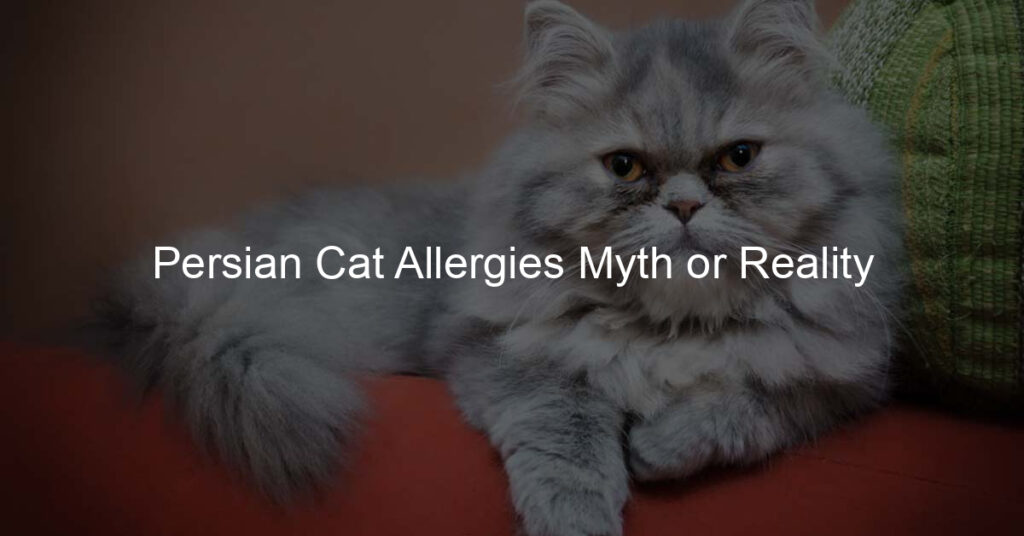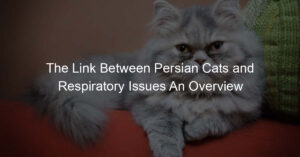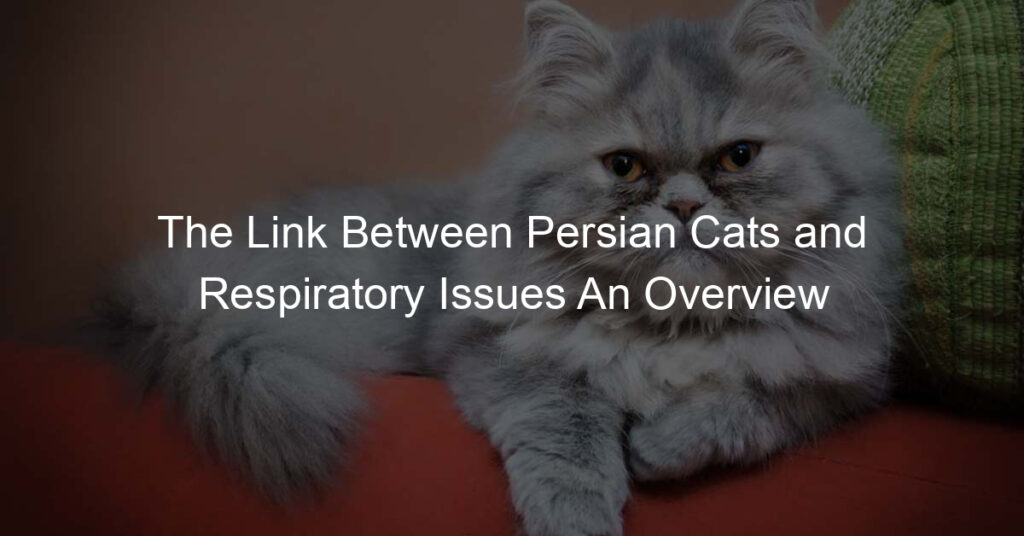It is often said that Persian cats are one of the most hypoallergenic breeds, making them a popular choice for individuals with allergies. However, there are many misconceptions surrounding allergies and Persian cats that require clarification. Understanding the truth about Persian cat allergies is essential for potential owners and allergy sufferers alike.
To begin, let’s explore the concept of allergies and what causes them. Allergies occur when the immune system reacts to certain substances, known as allergens, which are typically harmless to most people. Common allergens include pollen, dust mites, mold spores, and pet dander. When exposed to these allergens, individuals with allergies experience a range of symptoms, such as sneezing, coughing, itching, and respiratory issues.
The myth of Persian cat allergies suggests that these cats are hypoallergenic, meaning they produce fewer allergens or do not trigger allergies at all. However, it is important to dispel this misconception. Persian cats, like any other breed, can still produce allergens, such as dander and saliva, which can provoke allergic reactions in susceptible individuals.
While some people may claim to have fewer allergy symptoms around Persian cats compared to other breeds, this can vary greatly from person to person. Factors that may influence allergic reactions include the individual’s sensitivity, the severity of their allergies, and their immune system response.
If you are an allergy sufferer considering adopting a Persian cat, it is crucial to understand how to manage your allergies effectively. This article will provide tips for allergy sufferers and discuss hypoallergenic measures that can be taken to minimize allergic reactions. By arming yourself with accurate information, you can make an informed decision and potentially enjoy the companionship of a Persian cat without compromising your well-being.
Key takeaway:
- Persian cats may not be hypoallergenic: Contrary to popular belief, Persian cats may still cause allergies in some individuals.
- Understanding the causes and symptoms: It is important to be aware of the common causes and symptoms of allergies when it comes to Persian cats.
- Managing allergies with Persian cats: Allergy sufferers can take certain measures to minimize their allergic reactions when living with Persian cats.
Understanding Allergies
Understanding allergies is essential for individuals who suffer from them. It is crucial to have a comprehensive understanding of what allergies are and how they impact our bodies.
1. Allergies are a common and frequently misunderstood condition. They are an overreaction of the immune system to substances that are typically harmless. These substances, known as allergens, can include pollen, dust mites, certain foods, and pet dander.
2. When a person with allergies comes into contact with an allergen, their immune system mistakenly perceives it as a threat and initiates an immune response. This immune response can manifest in various symptoms, such as sneezing, itching, watery eyes, and wheezing.
3. A wide range of allergens can trigger allergies and can vary in severity. Some individuals may experience mild symptoms, while others may have more severe reactions that can be life-threatening, like anaphylaxis.
4. It is crucial to identify the specific allergen that triggers your allergies to effectively manage and avoid exposure to it. Allergy testing, conducted by a healthcare professional, can help determine the specific allergens affecting an individual.
5. Treatment for allergies may involve the use of medications, such as antihistamines, to alleviate symptoms. Additionally, allergen immunotherapy aims to desensitize the immune system to specific allergens.
Understanding allergies allows individuals to take necessary precautions to avoid allergens and seek appropriate treatments for symptom relief. If you suspect you have allergies, it is recommended to consult with a healthcare professional for a proper diagnosis and management.
In 18th-century Scotland, Dr. Alexander Blackwood played a pivotal role in advancing the understanding of allergies. As a perceptive physician, Blackwood noticed a distinct correlation between certain symptoms and exposure to pollen. He embarked on a relentless pursuit of knowledge, experimenting on himself by exposing his body to various allergens and meticulously documenting his reactions.
Blackwood’s pioneering research challenged the prevailing beliefs of the time, which attributed symptoms to various diseases and imbalances. Through his methodical scientific approach, he unequivocally demonstrated that allergies were a unique immunological response triggered by specific substances.
His groundbreaking work paved the way for further advancements in allergy research and revolutionized the diagnosis and treatment of allergies. Blackwood’s unwavering dedication and insatiable curiosity significantly contributed to our current understanding of allergies.
Today, thanks to trailblazers like Dr. Alexander Blackwood, we have a more comprehensive understanding of allergies and more effective methods for managing and treating them. Ongoing research continues to expand our knowledge and offer new possibilities for allergy prevention and relief for individuals worldwide.
What Causes Allergies?
A variety of factors can cause allergies. The immune system plays a key role in allergic reactions. When a person with allergies is exposed to an allergen, such as pollen or pet dander, their immune system mistakenly identifies it as harmful and launches an immune response. This response involves the release of histamines, which leads to common allergy symptoms like sneezing, itching, and runny nose.
Certain substances are more likely to trigger allergies than others. Some common allergens include dust mites, mold spores, pollen, pet dander, certain foods, and insect stings. It’s important to note that different people may be allergic to different allergens, and not everyone will have the same allergic reaction.
Genetic factors can also influence allergies. People with a family history of allergies are more likely to develop allergies themselves. Environmental factors can play a role. For example, living in an area with high pollen levels or being exposed to secondhand smoke can increase the risk of developing allergies.
It’s worth mentioning that while allergies cannot be cured, they can be managed. Avoiding allergens as much as possible, using over-the-counter antihistamines, and seeking medical treatment can help alleviate allergy symptoms. If you suspect you have allergies, it’s important to consult with a healthcare professional for a proper diagnosis and guidance on managing your specific allergies. Understanding what causes allergies is the first step towards finding relief and living a more comfortable life.
Runny nose, itchy eyes, and unpredictable sneezes – allergies have a knack for turning us into human fountains.
Common Allergy Symptoms
Common allergy symptoms include sneezing, nasal congestion, runny nose, itchy or watery eyes, coughing, and wheezing. These symptoms occur as a result of the body’s immune system reacting to allergens such as pollen, pet dander, dust mites, or mold spores.
Sneezing is a common symptom of allergies and is the body’s way of trying to expel the allergens from the nasal passages. Nasal congestion, or a stuffy nose, occurs when the blood vessels in the nasal tissues become inflamed and swollen. This can make it difficult to breathe through the nose.
A runny nose is another common symptom of allergies. It occurs when the body produces excess mucus in an attempt to flush out the allergens. Itchy or watery eyes can also be a result of allergies, as the body releases histamine in response to the allergens, causing irritation and watering of the eyes.
Coughing and wheezing are symptoms that can occur in individuals with respiratory allergies, such as hay fever or asthma. These symptoms are caused by the body’s immune response to the allergens, which can trigger inflammation and constriction of the airways.
It is important to note that the severity and specific symptoms of allergies can vary from person to person. Some individuals may experience only mild symptoms, while others may have more severe reactions. If you are experiencing common allergy symptoms, it is recommended to consult with a healthcare professional for proper diagnosis and treatment options.
Persian Cat Allergies: Fur-real or just a sneeze-inducing myth?
The Myth of Persian Cat Allergies
The topic of “The Myth of Persian Cat Allergies” has caused much confusion and misunderstanding. It is crucial to dispel the misconception that Persian cats are more likely to cause allergies compared to other cat breeds.
Contrary to popular belief, there is no scientific evidence to support the claim that Persian cats are more allergenic than other cat breeds. Allergies to cats are actually caused by a protein called Fel d 1, which is present in the saliva, dander, and urine of cats. This protein is not exclusive to Persian cats and can be found in varying amounts in all cat breeds.
While it is true that some individuals may be more sensitive to this protein and experience allergic reactions, it is important to note that it is not limited to Persian cats. The level of Fel d 1 can differ between individual cats, regardless of their breed. Factors such as genetics, age, and gender can influence the amount of Fel d 1 produced by a cat.
If you are considering getting a Persian cat and have concerns about allergies, there are steps you can take to minimize exposure to allergens. Regular grooming, keeping the cat out of the bedroom, and frequently cleaning carpets and upholstery can help reduce allergens in the environment.
The belief that Persian cats are inherently more allergenic than other cat breeds is a myth. The presence of allergies is not determined by the breed of the cat but rather by individual sensitivities. It is crucial to distinguish between fact and fiction and make informed decisions when it comes to owning a pet.
Are Persian Cats Hypoallergenic?
Persian cats are often advertised as hypoallergenic, but it is important to understand the reality of their hypoallergenic status. While some people may find Persian cats to be less allergenic than other breeds, it is essential to note that no cat breed is truly hypoallergenic.
Persian cats, known for their long, luxurious coats, are often labeled as hypoallergenic. However, it is crucial to recognize that this is not entirely accurate. These cats can still harbor allergens like dander and saliva, which can trigger allergic reactions in sensitive individuals.
Even if a Persian cat is bathed regularly and groomed to minimize shedding, the presence of allergens cannot be entirely eliminated. The level of allergenicity can vary from person to person, as everyone’s immune system reacts differently to these allergens. Some individuals may experience mild or no allergic reactions to Persian cats, while others may have more severe symptoms.
To make an informed decision, potential cat owners with allergies should spend time with Persian cats before bringing them into their homes. Observing any allergic reactions in the presence of the cat can help determine their tolerance.
Along with spending time with the cat, individuals with allergies can take certain measures to reduce allergic reactions. These measures include keeping the cat out of the bedroom, regularly cleaning the house, using air purifiers, and frequently washing hands after interacting with the cat. By adopting these precautions, exposure to allergens can be minimized, and symptoms can be alleviated.
Commonly mistaken for fluffy allergenic demons, Persian cats prove that looks can be deceiving.
Common Misconceptions
Common misconceptions about Persian cat allergies can lead to misunderstandings and misinformation. It is important to address these common misconceptions to provide accurate information to potential cat owners. Here are some common misconceptions about Persian cat allergies:
1. All Persian cats are hypoallergenic: This is not true. While some individuals may have fewer allergies or sensitivities to Persian cats, it does not guarantee that all Persian cats are hypoallergenic. Allergies can vary from person to person, and it is important to spend time with a Persian cat before bringing one into your home if you have allergies.
2. Persian cats do not cause any allergies: This is incorrect. Persian cats, like any other breed, produce allergenic proteins that can trigger allergies in sensitive individuals. These proteins are found in cat saliva, dander, and urine, and they can cause allergic reactions such as sneezing, itching, and congestion in susceptible individuals.
3. Washing a Persian cat eliminates allergies: While regular grooming and bathing can help reduce allergens on a cat’s fur, it does not completely eliminate the allergens. Allergenic proteins are also present in a cat’s skin and saliva, which grooming cannot completely remove. Therefore, washing a Persian cat may provide some relief but may not completely prevent allergic reactions.
4. Allergy shots can cure allergies to Persian cats: Allergy shots, or immunotherapy, can help reduce the severity of allergic reactions in some individuals, but they do not cure allergies. They work by gradually desensitizing the immune system to allergens, including those from cats. It is important to note that the effectiveness of allergy shots can vary from person to person.
5. Only long-haired Persian cats cause allergies: This is a misconception. Allergenic proteins are not specific to the length of a cat’s fur. Even short-haired Persian cats can produce allergenic proteins that can trigger allergies in susceptible individuals.
To manage allergies with a Persian cat, allergy sufferers should consult with their healthcare provider and consider the following tips: keeping the home clean, using air purifiers, establishing cat-free zones, and regularly grooming and bathing the cat. These measures can help reduce allergens in the environment and minimize allergic reactions.
By addressing these common misconceptions, potential Persian cat owners can make informed decisions regarding their allergies and the suitability of owning a Persian cat.
Reality Check: Persian Cats and Allergies
Persian cats and allergies: A Reality Check
Persian cats are often associated with allergies, but it is important to provide a reality check on this issue.
1. Allergy prevalence: While it is true that some people are allergic to cats, it is not accurate to assume that all Persian cats will cause allergies. Allergy prevalence varies, with estimates suggesting that about 10% of the population is allergic to cats.
2. Allergen source: The main allergen associated with cats is a protein called Fel d 1, which is found in their saliva, urine, and skin dander. Persian cats, like all cats, produce Fel d 1. It is important to note that individual cats can vary in the amount of allergens they produce.
3. Grooming and shedding: Persian cats have long, luxurious coats that require regular grooming to prevent matting and excessive shedding. Routine grooming can help reduce the amount of allergens present in the environment.
4. Hypoallergenic claims: Some breeders and companies may claim that certain breeds, including certain types of Persians, are hypoallergenic. There is no scientific evidence to support these claims. Hypoallergenic breeds are often marketed as producing fewer allergens, but individual sensitivities can still vary.
5. Managing allergies: If you or a family member are allergic to cats, there are steps you can take to manage allergies. Regular cleaning, including vacuuming and dusting, can help reduce allergens in the environment. It is also recommended to create pet-free zones within the home where allergic individuals can seek relief.
While Persian cats, like all cats, produce allergens, it is not accurate to assume that all individuals will be allergic to them. By understanding the science behind allergies and taking appropriate measures, it is possible to coexist with a Persian cat without experiencing severe allergic reactions.
Can Persian Cats Cause Allergies?
Persian cats are often associated with allergies, but can Persian cats actually cause allergies? The answer is yes. Despite the misconceptions and debates surrounding the topic, Persian cats can be a trigger for allergic reactions in some individuals.
While it is not accurate to claim that all Persian cats are hypoallergenic, it is important to understand that a specific breed of cat does not solely cause allergies. Rather, allergies are typically triggered by proteins found in a cat’s saliva, urine, or dander.
Being a long-haired breed, Persian cats can produce more dander compared to short-haired cats. Dander, which consists of tiny flakes of dead skin, can easily become airborne and subsequently inhaled by sensitive individuals. When these proteins come into contact with the immune system of someone with allergies, it can lead to common allergy symptoms such as sneezing, itching, and watery eyes.
It is worth noting that the severity of allergies can vary among individuals. Some people may develop mild symptoms, while others may experience more severe reactions. Factors such as the individual’s sensitivity, exposure, and overall health can influence the severity of allergic reactions to Persian cats.
If you are prone to allergies but still wish to own a Persian cat, there are measures you can take to help manage your allergies. Regular grooming, including brushing and bathing your cat, can help reduce the amount of loose hair and dander in the environment. Keeping your living space clean and well-ventilated can also minimize allergen exposure.
So, while Persian cats can indeed cause allergies in some people, it is essential to remember that allergies are not exclusive to this specific breed. Allergies to cats are a complex matter influenced by various factors.
Sniffles and sneezes, beware! These factors could unleash the wrath of allergic reactions when it comes to Persian cats.
Factors That May Influence Allergic Reactions
When it comes to allergic reactions, several factors can influence their severity and frequency. It’s important to understand these factors to better manage allergies, especially when considering owning a Persian cat. Here are some key factors that may influence allergic reactions:
1. Exposure level: The level of exposure to allergens, such as pet dander, can greatly impact the severity of allergic reactions. Higher exposure levels can lead to more frequent and intense symptoms.
2. Sensitivity to allergens: Each individual has a different level of sensitivity to specific allergens. Some people may be highly sensitive to pet dander, while others may have a milder response. Understanding your sensitivity can help you assess the potential impact of owning a Persian cat.
3. Personal immune system: The functioning of your immune system plays a crucial role in the severity of allergic reactions. A strong immune system may be able to better tolerate allergens, whereas a compromised immune system can lead to more pronounced symptoms.
4. Allergen management: Proper allergen management can help reduce exposure and minimize allergic reactions. Regular cleaning, vacuuming, and dusting can help remove pet dander from your living environment, lowering the risk of allergic reactions.
5. Other allergies: If you already have existing allergies, such as pollen or dust allergies, they can potentially exacerbate your reaction to pet dander. Multiple allergies can add to the overall burden on your immune system.
6. Genetic predisposition: Genetics can also play a role in determining your susceptibility to allergies. If there is a family history of allergies, you may be more likely to experience allergic reactions, including those caused by pet dander.
By considering all of these factors, individuals can make informed decisions about owning a Persian cat and managing potential allergic reactions. It’s essential to consult with a healthcare professional to assess personal risks and develop appropriate strategies for allergy management.
Managing Allergies with a Persian Cat
If you’re an allergy sufferer, owning a Persian cat may not be as impossible as it seems. In this section, we’ll explore ways to manage allergies while enjoying the company of these fluffy feline friends. Get ready for some helpful tips and discover the hypoallergenic measures you can take to make living with a Persian cat a reality rather than just a myth!
Tips for Allergy Sufferers
For allergy sufferers considering getting a Persian cat, here are some important tips to manage your allergies:
Tips for Allergy Sufferers
For allergy sufferers considering getting a Persian cat, here are some important tips to manage your allergies:
| Implement proper home cleaning routines: Make sure to regularly vacuum your carpets, dust surfaces, and wash bedding to minimize the presence of allergens. |
| Create designated areas without pets: Set specific zones in your home, such as your bedroom, where your cat is not allowed to establish allergen-free spaces. |
| Consider using air purifiers: Using air purifiers equipped with HEPA filters can effectively remove allergens from the air. |
| Regularly groom your Persian cat: By grooming your Persian cat frequently, you can reduce the amount of loose hair and dander that may trigger allergies. |
| Practice good hygiene: Remember to wash your hands after interacting with your cat to minimize the potential transfer of allergens. |
| Consult with a healthcare professional: It’s advisable to seek advice from your doctor or allergist regarding suitable allergy medication to alleviate your symptoms. |
| Discuss with breeders: If you plan to purchase a Persian cat from a breeder, have a conversation about your allergies and inquire about the hypoallergenic measures they take in their breeding program. |
These valuable tips can help allergy sufferers effectively manage their symptoms while enjoying their time with a Persian cat. However, it’s crucial to keep in mind that individual allergic reactions may vary, so consulting with a healthcare professional is essential before making any decisions.
Taking measures to minimize allergens can help you enjoy your Persian cat without needing to use your inhaler as a fashion accessory.
Hypoallergenic Measures
Several hypoallergenic measures can be taken to minimize allergic reactions to Persian cats:
Several hypoallergenic measures can be taken to minimize allergic reactions to Persian cats:
- Employ hypoallergenic measures: Create a cat-free zone in your home, especially in your bedroom, to reduce exposure to allergens.
- Regular grooming: Regularly brush your Persian cat to remove loose hair and dander, which can trigger allergies. Consider using hypoallergenic cat shampoo to minimize allergens on the cat’s fur.
- Cleanse your hands: Thoroughly wash your hands after handling your Persian cat to remove any allergens that may have been transferred from their fur.
- Enhance indoor air quality: Use high-efficiency particulate air (HEPA) filters in your home to capture allergens from the air. Vacuum and clean surfaces regularly to minimize the buildup of allergens.
- Consider allergy medications: Consult with your healthcare provider about taking over-the-counter or prescription allergy medications to manage symptoms caused by Persian cat allergies.
- Seek advice from an allergist: If you are considering getting a Persian cat but have allergies, it is recommended to consult an allergist to conduct allergy testing and discuss potential treatment options.
By embracing these hypoallergenic measures, you can help reduce the allergens associated with Persian cats and potentially alleviate allergic reactions in sensitive individuals.
Some Facts About Persian Cat Allergies: Myth or Reality?
- ✅ Persian cats are often assumed to be bad for allergies due to their long hair.
- ✅ Hypoallergenic cats are breeds that are less likely to cause allergies, but no cat is 100% hypoallergenic.
- ✅ Persian cats are not hypoallergenic and can bring out allergies due to their long coats.
- ✅ All cats produce the protein Fel d 1 in their saliva, but unneutered male cats tend to produce more.
- ✅ Some breeds that are said to be lower allergy cats include the Siberian Cat, British Shorthair, Russian Blue, Siamese, Bengal, Devon Rex, Cornish Rex, Abyssinian, Balinese, Oriental Shorthair, Sphynx, Javanese, and Ocicat.
Frequently Asked Questions
Are Persian cats hypoallergenic?
No, Persian cats are not hypoallergenic. Although they produce less dander than other breeds, they can still trigger allergies in sensitive individuals due to the allergens present in their saliva, urine, and skin oils.
Can Persian cats cause asthma attacks?
Yes, Persian cats can potentially cause asthma attacks in individuals who are allergic to cats. The allergens produced by Persian cats, such as the Fel d 1 protein, can irritate the airways, leading to asthma symptoms.
What breeds are considered low-allergy cats?
Some breeds that are known to be relatively low allergy cats include the Siberian Cat, British Shorthair, Russian Blue, Siamese, Bengal, Devon Rex, Cornish Rex, Abyssinian, Balinese, Oriental Shorthair, Sphynx, Javanese, and Ocicat. However, it’s important to note that no cat breed is completely free of allergens.
Can grooming a Persian cat reduce allergies?
Grooming a Persian cat regularly can help reduce allergies. By grooming, you remove loose hair and dander from the cat’s coat, reducing the amount of allergens that might be floating around your home. It’s advisable to bathe the cat occasionally to further minimize dander and saliva proteins.
Do unneutered male cats produce more allergens?
Yes, unneutered male cats tend to produce more allergens, such as the Fel d 1 protein, compared to neutered males and female cats. It is recommended to consider neutering your cat to potentially lower the levels of allergens in their saliva.
Is the myth of hypoallergenic cat breeds true?
No, the idea of hypoallergenic cat breeds is a myth. While some breeds produce fewer allergens than others, no cat breed is entirely free of allergens. It’s essential for individuals with allergies to spend time with a cat before adopting to determine their particular sensitivity to that specific cat.














